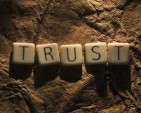
Those who do embark on a journey of personal transformational have great courage, for they must be willing to face and explore both the light and dark aspects of their personality. And yet even the bravest among us falter when the doubt becomes too heavy, when the path is unclear, when we don’t understand why things are happening the way they are.
Cultivating trust is an essential part of the journey, particularly when things seem to be falling apart and the way forward unknown.
What are some ways we can help our clients establish the Trust Zone?
1. Have your clients draw a circle (in their mind or paper) and call it the trust zone. As doubts, fears, uncertainties and frustrations arise through your conversation, put them outside of the trust zone. Once the ideas stop coming, begin a process of try to find ways to move the ideas into the trust zone.
2. Give voice to the doubt. What is it saying? Give voice to the skeptic? What is it saying? Give voice to the critic. What is it saying?
3. One of the most effective ways to move from doubt to trust is action. Sometimes an action catalyzes the shift. A “feel the fear, and do it anyway” approach. It’s possible to have fear and doubt and apprehension and still move forward. If your clients are in action, they don’t stay in doubt very long.
4. Establish and step into the state of trust. What does it feel like? Sound like? Taste like? Look like? What are the effects of trust? Where in the past did you feel trust? Create the awareness in your client that they are now free to choose trust as a state of being.
5. Reframe perspectives. Ask questions like: What if this thing that is happening is exactly what needs to be happening? How would your response be different? Help them to open up and reframe limiting perspectives on the goodness and rightness of the way things are unfolding in their lives.
6. Acknowledge clients for their successes, for what is working, for the positives that are happening in their lives.
7. Validate. My certainty and trust in you and what is happening is greater than your doubt.
8. Play out the doubt. What is the worst possible thing that could happen? And what would you learn from that worst possible thing happening?
9. Creating awareness of underlying beliefs to help clients see the belief as a pattern that served at one point in their life. It’s not “who they are” but rather a thought that they have chosen to believe is true.
10. If there is a lot of doubt, help clients shift into trust by helping them create a support system or a safety net. Do they surround themselves with people who believe in and support them? Explore this. Create actions around it.
11. Model positivity. You, the coach, must radiate trust, both in your client and in the process, regardless of what is happening on the surface level. You must be the embodiment of what it means to live in the trust zone. (And if you are not, you have your work to do.)
12. Practice deep acceptance…of self and of the situation. (This one is a real challenge for people who are deeply frustrated and mistrusting of the transformational process.)
13. Be patient. Transformation is no overnight process. Help your client not only accept what is happening, but also to be patient with the process so that it can unfold naturally and organically (nothing needs to be forced or made to happen).
14. Coach from a heart level. Get out of your head, get your client out of their head, and drop into the heart space, where a higher truth is available.
Help your clients to understand the most empowering perspective of all: life is a life-long journey, a continual opportunity for discovery, exploration and learning. Whatever situation they are going through is perfect as it is, and always an opportunity for learning the life lesson that needs to be learned.

